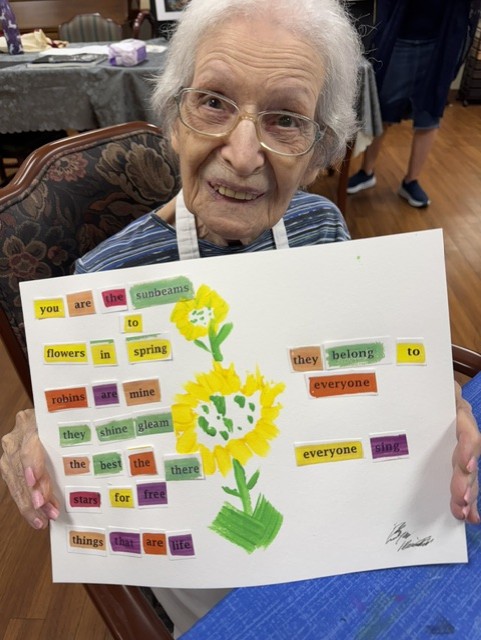When I was a new pastor visiting congregational members in the hospital, I was surprised when some would deny pain or brush aside comfort. Instead, they would say, “I’m just grateful I have life,” even though they were grappling with cancer, serious diseases or debilitating pain. At first, I viewed their gratitude suspiciously. Was it just a pat answer to push down grief or deny pain? But after pastoring for 13 years and being the chaplain for a retirement community for six years, I’m beginning to discover a new way of living through the spirituality of gratitude.
Gratitude as Choice
The spirituality of gratitude involves a choice. When my husband calls me at work to discuss dinner plans, I can either choose to see it as an interruption or as communion or provision. When a resident asks to see me because they are anxious, I can see this as one more thing in an already busy day or an opportunity for community. Why is choice and perspective so important? Because if I choose gratefulness, there is more chance that I will experience happiness. In addition, when we practice the spirituality of gratitude, we can pass it on.
You might be thinking, “Pollyanna’s annoy me.” Me too. I battle my own cynicism that the world is going downhill fast. The reality is we cannot be grateful for all things like death, global-warming, famine or cancer. It’s not appropriate to give thanks for suffering. But you can be grateful at all times. You’re not grateful for death and suffering, but you can be grateful for other people, experiences or things along the way. In fact, significant scientific research in the last 10 years has focused on the issue of gratitude affecting health and happiness. Much of that research shows that gratitude is actually beneficial for both our bodies and minds. People who are regularly grateful — who acknowledge the goodness in life and the sources of it — are generally healthier and happier (“Gratitude and Well Being: The Benefits of Appreciation”, Randy A. Sansone, MD and Lori A. Sansone, MD, Psychiatry, 2010).
We practice gratitude not because we ought but because it is natural. Humans are hardwired to have gratitude well up in our hearts, quiet and overwhelming, which often turns into thankfulness: “Wow!” or “I’m so thankful for you.” Gratitude recognizes life is a gift we receive, rather than earn. Like the spirituality of wonder, it begins with slowing or stopping.
Active Gratitude
Benedictine David Steindl-Rast delineates three aspects to the practice of gratitude. (“Anatomy of Gratitude,” On Being). The first is to “stop,” which involves becoming aware of this present moment or this present breath. Breathe in and let your mind settle on this moment. Maya Angelou captures this aspect when she writes:
“This is a wonderful day. I’ve never seen this one before.”
Second, “look” and “listen.” Use all your senses to sniff out the gift of this place, person or event. Gratitude is full-blooded and full-bodied. As the Psalmist recommends, “Taste and see that the Lord is good.”
Third, “go.” Avail yourself of this moment of opportunity and act on its behalf. Let the moment grasp you and allow it to move you, so that your heart rises like a balloon on the breeze. Often, gratitude invites us to enjoy. But often, we are motivated to share that joy which begins to positively transform our communities, if not the world.
Gratitude: Zest for Life
This week, a nursing assistant stopped to talk to me about a resident named Betty. Her husband of 80 years died last month, and we anticipated she would quickly join him. Instead, we have seen her sadness and physical decline morph into smiles and zest for living, as well as the enjoyment of visiting with other residents and friends. The nursing assistant said to me, “Beth, I think we were wrong about Betty.” She smiled:
“I think Betty has more good life to live.”
And we both marveled at the mystery of the human spirit and joy of life today.
Have you ever awakened in the middle of the night with your mind whirling and your heart tripping in worry? You can’t settle yourself because the world feels like it is out of control and you are almost paralyzed with worry and indecision. What I stumbled upon was an antidote to my fear. I begin to create a list of things I’m grateful for: a warm place to sleep; a new day that will be filled with light rather than dark; people I care about; the ability to walk and talk; breath. And as my list lengthens, I feel a shift within me: my perspective widens and changes. Surrounded by good things and good people, my worry begins to shrink. Suddenly, my heart opens to the richness of life and leaps from anxiety to hope. This is the spirituality of gratitude at work.
I encourage you to make the spirituality of gratitude part of your life. Make a gratitude list. Or put post-it notes around the house reminding yourself what you’re grateful for. Dole out thanks daily to family and coworkers. Keep a gratitude journal. However, be sure to tailor your practice to what works for you. Then, notice how your head and heart respond. And finally, pass it on. Grateful people make a joyful world.
There are a wide variety of spiritual practices one can explore. Please join with us as we celebrate an abundance of spiritual practices on our journey through this season from Epiphany through Lent.
View all articles by:






















